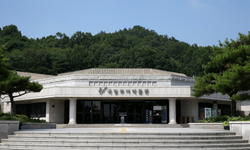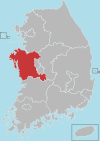Buyeo 부여군 | |
|---|---|
| Korean transcription(s) | |
| • Hangul | 부여군 |
| • Hanja | 扶 餘 郡 |
| • Revised Romanization | Buyeo-gun |
| • McCune-Reischauer | Puyŏ-gun |
 Buyeo National Museum | |
 Location in South Korea | |
| Country | |
| Region | Hoseo |
| Administrative divisions | 1 eup, 15 myeon |
| Government | |
| • Mayor | Park Jeong-hyeon(박정현) |
| Area | |
• Total | 624.65 km2 (241.18 sq mi) |
| Population (September 2024 [1] ) | |
• Total | 59,823 |
| • Density | 152.4/km2 (395/sq mi) |
| • Dialect | Chungcheong |
Buyeo County (Buyeo-gun) is a county in South Chungcheong Province, South Korea. Buyeo-eup, the county's capital, was the site of the capital of Baekje from 538-660 AD, during which it was called Sabi Fortress.
Contents
- Geography
- Climate
- Commerce
- Baekje Cultural Festival
- Sister cities
- See also
- References
- External links
Famous people associated with Buyeo County in more recent times include noted stem-cell researcher Hwang Woo-suk.



